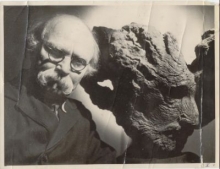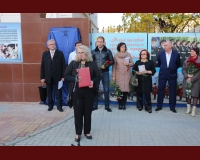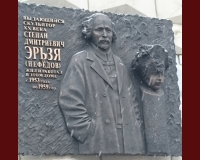News
On November 8, 2016, in relation to the celebration of the 140th anniversary of Stepan Erzia, and together with the authorities of the hero city Novorossiysk..
On February 3, 2015, the Erzia Art Foundation together with the Moscow Department of Culture inaugurated a memorial plate in Moscow at No. 3..
About S.Erzia
 Stepan Dmitrievich Nefedov (Erzia) was born on 8 November (October 27), 1876 in the village Bayevo belonged to Alatyr District of Simbirsk Province (now it is the Republic Mordovia) in the family of peasants.
Stepan Dmitrievich Nefedov (Erzia) was born on 8 November (October 27), 1876 in the village Bayevo belonged to Alatyr District of Simbirsk Province (now it is the Republic Mordovia) in the family of peasants.
His talent had been developed first of all at Moscow school of painting, sculpture and architecture (1902-1906) and then in sculptural studios in Europe (1907-1914).
The young sculptor first presented his works at the XXXVIth student exhibition of Moscow School of Painting, Sculpture and Architecture in 1903.
In the spring of 1907 he came to Italy, where a Mordovian peasant Nefedov could become famous under the pseudonym taken in honor of his native nationality – Erzia. In 1909 in Venice he took part at the International Art Exhibition where he presented his works “The Last Night Before an Execution” (1909) and “Self-Portrait” (1908). The exhibition brought success to the young sculptor. Later in Milan Erzia started to work actively in a genre of portraiture. His work “Pope” (1909) displayed at the Milan Art Exhibition in 1909 attracted the attention of the local critics. During the early years of his staying in Italy Erzia was actively developed into a master who worked hard and variously.
In 1910 having moved in Nice, Erzia did not stay there for a long time. He left for Paris where Erzia tried to master Rodin`s plastic method. That time work with marble became a new stage for the sculptor. To work with it he decided to return to Italy in 1914 and settled in the province Massa-Carrara.
During this period of his life (1907-1914) Erzia became not only one of the most original, but also one of the most professional Russian sculptors. In 1914 hereturned to Russia, where Erzia`s talent, great capacity to work and the European professional experience developed in full.
The October revolution of 1917 made the important changes in Erzia`s creative life. His participation in realizing Lenin`s plan of monumental propaganda in the Urals and in the Caucasus (1918-1925) changed his manner. This theme the sculptor executed in multimeter monuments in the squares of Yekaterinburg, Baku, Batumi.
His next trip to Paris in 1926 was organized on the initiative by A.Lunacharsky. In the Parisian Palace of Fine Arts there was held his personal exhibition attracted Erzia`s creative activity for the period since 1915. Soon at the invitation of the President of Argentina he came to Buenos Aires. During the Argentina period, the longest in his creative evolution (1927-1950), Erzia worked with a new material – wood quebracho which he had found in this country. This material required from the master another creative manner, but the themes did not change.
Two decades of Erzia`s creative work and life in Argentina not only enriched his professional experience but also brought an important contribution to the development of the local sculptural school. He has created works many of which are a part of the world art treasury.
Stepan Erzia returned to the Soviet Union in 1950 where he spent the last nine years of his unusual life. Erzia died in 1959 in his studio in Moscow. He was buried in Saransk but his art without knowing any borders, belongs to the mankind.
Erzia is called “Russian Roden” by his contemporaries. He has undoubtedly made a significant contribution into the culture of arts, but unfortunately, has neither received proper evaluation nor determined his own place in modern Russian art. Erzia’s name has already become the flag ship of culture for a small Finno-Ugric nation - Mordva, and is now awaiting its advancement to the universal level. The creation and activity of International Fund dedicated to Erzia in Moscow is therefore quite reasonable, as it is the largest cultural centre of Russia with great financial and social opportunities for realization of the most ambitious international artistic projects. Otherwise it would be impossible for one of the most talented contemporary sculptors, whose name deserves to stand alongside with the names of Rodin, Maiol, Brancusi, Mestroviж, Konenkov and Golubkina, to return from the long-term oblivion.
Erzia’s life is closely connected with this city. He has studied in Moscow, he has returned to Moscow after long years spent in foreign lands, Moscow is the city where the unforgettable exhibition of his outstanding works has taken place, and here he has passed away to Eternity… Not only happy, but also tragic pages of Erzia’s life are related to Moscow. It may sound strange, but until today Moscow has no place where one could learn about this amazing artist. Thus it is not accidental why Moscow is the very place where Stepan Erzia renaissance should start. And it is starting today.






